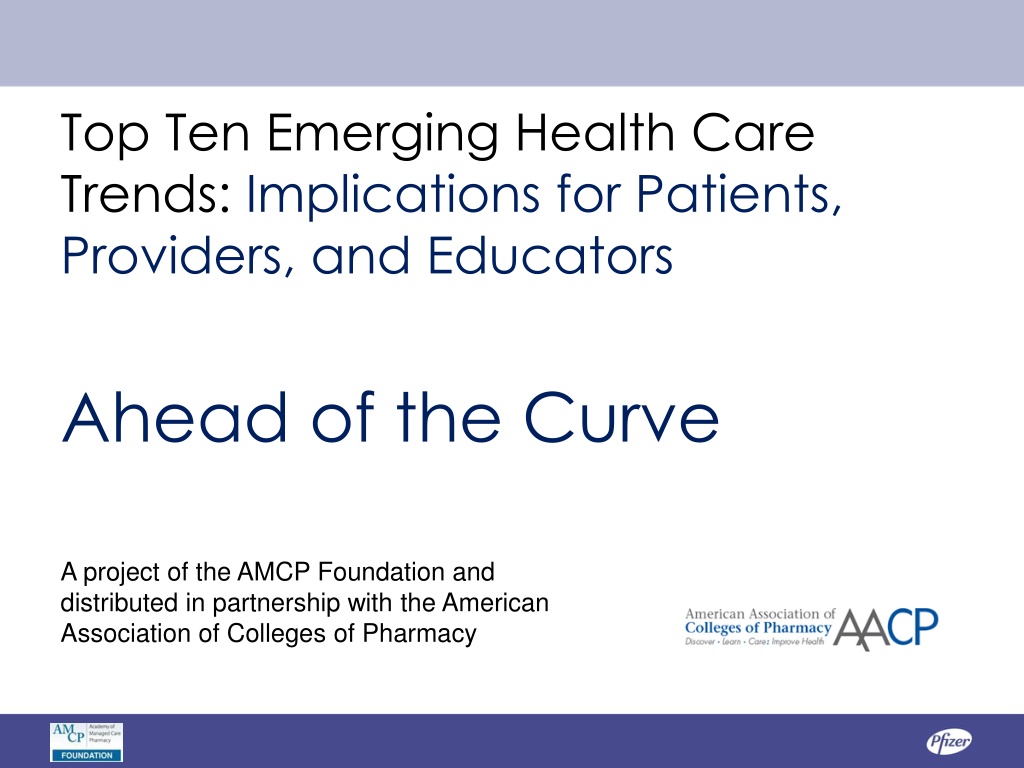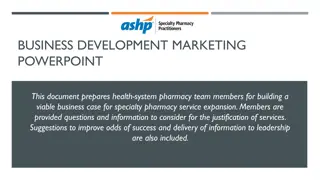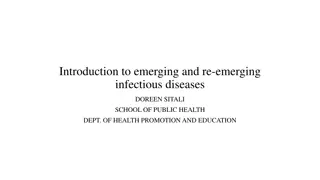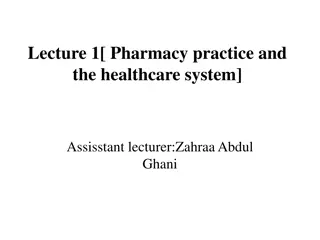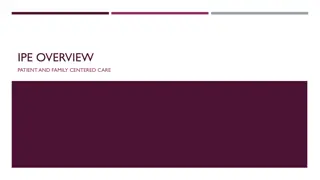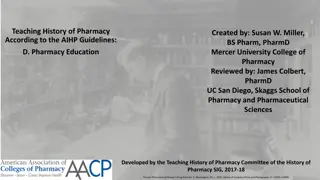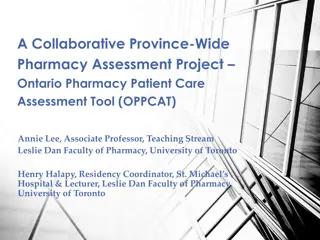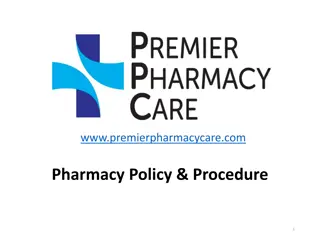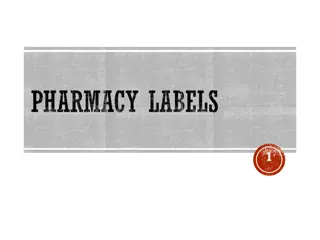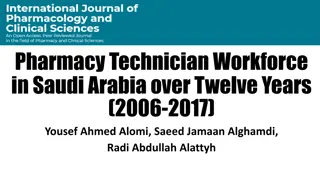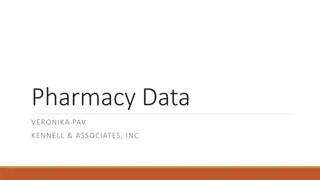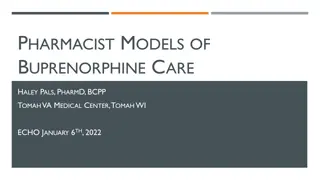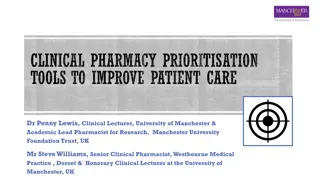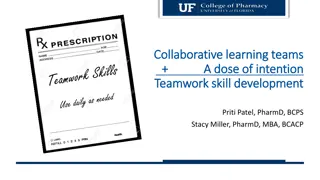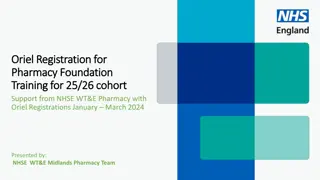Emerging Health Care Trends: Implications for Pharmacy Education
The evolving landscape of healthcare demands that pharmacy educators understand and adapt to current trends. This report, a collaborative effort by AMCP Foundation and American Association of Colleges of Pharmacy, delves into crucial changes impacting patients, providers, and educators. It emphasizes the need for leadership in preparing pharmacy students for future challenges and opportunities. The study identifies top emerging trends and offers insights for educators to reshape their curriculum and organizations effectively.
Download Presentation

Please find below an Image/Link to download the presentation.
The content on the website is provided AS IS for your information and personal use only. It may not be sold, licensed, or shared on other websites without obtaining consent from the author. Download presentation by click this link. If you encounter any issues during the download, it is possible that the publisher has removed the file from their server.
E N D
Presentation Transcript
Top Ten Emerging Health Care Trends: Implications for Patients, Providers, and Educators Ahead of the Curve A project of the AMCP Foundation and distributed in partnership with the American Association of Colleges of Pharmacy
Introduction 20 years ago: The American Association of Colleges of Pharmacy (AACP) issues the Janus Commission Report, restating colleges of pharmacy s responsibility to navigate changes on the horizon Today: The pace of change is accelerating, and it will be critically important for pharmacy educators: To comprehend today s trends and their far-reaching implications To assume leadership roles in moving the pharmacy profession To prepare students for the challenges and opportunities ahead 2
Introduction (contd) This module helps delineate today s most critical changes, identify trends that are inter-related, and identify opportunities for pharmacy leaders, including educators, to reshape their organizations to meet today s and tomorrow s challenges. Ahead of the Curve presents the results of a survey that identifies and links these changes, and suggests ways pharmacy educators can prepare the leaders of tomorrow.
Outline Study Background and Objectives Top Ten Emerging Health Care Trends Implications for Pharmacy Educators 4
Study Background The US health care system is in a constant state of change The Patient Protection and Affordable Care Act (ACA) placed the Triple Aim of health care center stage Improving Pt Satisfaction and Care Quality 5
The Education of Pharmacy Students Must Reflect Today s Changes and Emerging Trends Health care stakeholders are increasingly asked to do more with less Costs of medicines escalating in parallel with growing requirements for improved patient outcomes Migration from volume to value in the health care marketplace Current need to identify and assess the impact of the rapidly changing dynamics in the US health care system to proactively prepare for expected changes
Goals of the Research Initiative Top 10 care pharmacy in the next5years emerging trends in US health care impacting managed RESEARCH GOAL: Identify the top ten emerging health care trends expected to have a significant impact on managed care pharmacy organizations in the next five years ADDITIONAL STUDY OBJECTIVES: Provide real-world insights on key health policy priorities relevant to a set of broader health care stakeholders Develop a comprehensive reference resource for managed care provider organizations, health care payers, policy makers, and other stakeholders 7
Advisory Panel for Ahead of the Curve THOUGHT LEADER PROFESSIONAL AFFILIATION Research Associate Professor & Associate Director, PORC at the University of Utah College of Pharmacy Joseph Biskupiak, PhD, MBA Former Health Care Policy Advisor, the White House (National Economic Council) Chris Dawe Jeffrey Dunn, PharmD, MBA Senior Vice President, VRx Pharmacy Services Medical Director, Northeast Business Group on Health (NEBGH); Executive Director, NEBGH Solutions Center Jeremy Nobel, MD, MPH Sandy Robinson, BA, MPA Senior Vice President, Avalere Health Executive Vice President and CEO of the National Alliance of State Pharmacy Associations Rebecca Snead, RPh Mark Snyder, MD Specialist Leader, Deloitte Consulting Research Professor and Project Director, Center on Health Insurance Reforms at Georgetown University Health Policy Institute JoAnn Volk, MA Director of Medicare Pharmacy Clinical Programs at Coventry Health Care, Inc./Aetna Mitzi Wasik, PharmD, BCPS Jed Weissberg, MD Senior Fellow, the Institute for Clinical and Economic Review 8
Outline Study Background and Objectives Top Ten Emerging Health Care Trends Implications of Emerging Trends for Pharmacy Educators 9
Top 10 Trends Countdown 1 2 3 4 5 6 7 8 9 10 Health care everywhere 10
10 Health Care Everywhere The Location of Care is Shifting Beyond Health Care Facilities Non-Physician Care Roles are Expanding Innovations in Technology are Fueling Enhanced Patient Engagement A New Generation of Health Care Roles Will Emerge New Care Settings Bring New Challenges in Coordination 11
Current Trends: 10 Health Care Everywhere CHANGING THE PLACE OF CARE REDEFINING PATIENT OUTREACH MEDICALIZATION OF CONSUMER DEVICES 12
Looking Ahead: Health Care Everywhere 10 Opportunities Ahead Expanded role for retail pharmacies Technologies and devices to enable physician extenders New roles in the health care workforce Challenges Ahead Care coordination and continuity of care Data portability and technology integration For Educators Focusing on coordination-of-care training Expansion of pharmacy practice areas: patient care and outreach Offering experiential training in innovative settings 13
Top 10 Trends Countdown 1 2 3 4 5 6 7 8 9 10 Increasing patient cost sharing Health care everywhere 14
9 Increasing Patient Cost Sharing Patient Cost Sharing is Increasing New Provider Payment Models May Increase Patient Financial Risk Non-financial Approaches are Needed to Effectively Engage Patients 15
Current Trends: 9 Increasing Patient Cost Sharing COST SHARING FOR PHARMACEUTICALS IS RISING PATIENT ENGAGEMENT IS IMPORTANT IMPACT OF COST SHARING ON CARE SEEKING BEHAVIORS BENEFIT DESIGNS ARE INCREASING PATIENT FINANCIAL RISK 1. Magellan Pharmacy Solutions 2012; 2. CVS Caremark 2013; 3. PwC Health Research Institute 2013b; 4. Blumenthal 2013; 16
Looking Ahead: 9 Increasing Patient Cost Sharing Opportunities Ahead Promoting the use of high value services Increasing patient ownership over disease management Challenges Ahead Balanced risk sharing models are needed Changes in provider payment and health system delivery For Educators Raise awareness that greater patient cost sharing has the potential to limit adherence with therapies, without appropriate balances Understand that methods to optimize patient decision making will require novel consumer-focused technologies 17
Top 10 Trends Countdown 1 2 3 4 5 6 7 8 9 10 Role of technology in patient engagement Increasing patient cost sharing Health care everywhere 18
Role of Technology in Patient Engagement 8 8 The Rise of Health Care Technologies is Empowering Patients Technology Tools Support Communication and Decision-Making Patients are Becoming Consumers Patient Education and Technology Coordination are Keys to Success The Digital Divide is a Risk for Some 19
Current Trends: Role of Technology in Patient Engagement 8 8 PATIENTS WILL DRIVE TECHNOLOGY USE TECHNOLOGY IN DISEASE MANAGEMENT TECHNOLOGY IN MEDICATION MANAGEMENT DEMOGRAPHICS IMPACT USAGE 20
Looking Ahead: 8 8 Role of Technology in Patient Engagement Opportunities Ahead Improved patient health care decision-making Patient ownership over disease management Challenges Ahead Patient education including health literacy and e-literacy Coordination of technologies The digital divide For Educators Technology will play several roles in connecting to patients regarding their pharmaceutical care and cost sharing 21
Top 10 Trends Countdown 1 2 3 4 5 6 7 8 9 10 Growth and performance of accountable care organizations Role of technology in patient engagement Increasing patient cost sharing Health care everywhere 22
7 8 7 Growth and Performance of ACOs ACOs are Expanding Early Data on ACOs are Promising ACO-Type Thinking is a Necessary Transitional Step Data and Analytics Will be Key for ACOs A Broader Culture Shift is Needed to Bend the Cost Curve 23
Current Trends: 7 8 7 Growth and Performance of ACOs PUBLIC & PRIVATE ACOS ARE ON THE RISE PIONEER ACOS MIXED RESULTS APPEAL OF THE ACO MODEL 1. Muhlestein 2013a; 2. Gold 2014; 3. Ignagni 2013; 4. Sanofi 2013; 5. Petersen 2013; 6. Muhlestein 2013b; 7. CMS 2013; 8. Gold 2014 24
Looking Ahead: 7 8 7 Growth and Performance of ACOs Opportunities Ahead Dual focus on cost and quality Data-driven insights Challenges Ahead Reduced provider autonomy Sharing revenue Fragmented health system For Educators ACO and shared-savings models offer opportunities for pharmacy Shared savings through better adherence and persistence? University-based health systems and ACOs: an opportunity for student experience? 25
Top 10 Trends Countdown 1 2 3 4 5 6 7 8 9 10 Migration to value-oriented health care marketplace Growth and performance of accountable care organizations Role of technology in patient engagement Increasing patient cost sharing Health care everywhere 26
Migration to Value-Oriented Health Care Marketplace 6 7 8 6 Migration to Value-Oriented Marketplace is Occurring Defining Value Will be Necessary Meaningful, Measurable Patient Outcomes Must be Defined and Tracked Multi-faceted Approaches Will be Needed 27
Current Trends: Migration to Value-Oriented Health Care Marketplace 6 7 8 6 DRIVING VALUE THROUGH INCENTIVES CHALLENGES IN PAYING FOR VALUE FINANCIAL INCENTIVES ALONE MAY NOT DRIVE VALUE 28
Looking Ahead: Migration to Value-Oriented Health Care Marketplace 6 7 8 6 Opportunities Ahead Era of value-based marketplace Paying for value instead of services Challenges Ahead Lack of consistent definition of value Lack of available data For Educators Ensure pharmacy students grasp the concept of value in health care treatment (from both the patient s and system s perspective) Champion a dialogue on standard benchmarks for value Establish procedures to iteratively evolve the definition of value 29
Top 10 Trends Countdown 1 2 3 4 5 6 7 8 9 10 Medicaid expansion due to health care reform Migration to value-oriented health care marketplace Growth and performance of accountable care organizations Role of technology in patient engagement Increasing patient cost sharing Health care everywhere 30
Medicaid Expansion due to Health Care Reform 5 6 7 8 5 Medicaid Enrollment is Increasing States Hold the Power to Drive Expansion Cost Reduction and Care Efficiency Will be Key Medicaid Expansion Will be a Hot Bed of Innovation for Change Improved Outcomes With Lower Reimbursements Will be Necessary 31
Current Trends: Medicaid Expansion due to Health Care Reform 5 MEDICAID ENROLLMENT WILL RISE STATE RESPONSES WILL VARY MEDICAID EXPENDITURES WILL RISE EXPANSION WILL HARNESS NEW CARE DELIVERY MODELS 1. Sanofi 2013; 2. Cannon2012; 3. KFF 2014; 4. The Advisory Board Company 2014; 5. Rudowitz 2014; 6. Kocot 2013 32
Looking Ahead: Medicaid Expansion due to Health Care Reform 5 Opportunities Ahead A hot bed of innovation New roles Challenges Ahead Potential trickle-down effect of financial risk Difficult processes for treating and paying for the uninsured For Educators Greater opportunities for pharmacy to play new roles in primary care and on the care team More need than ever for pharmacy students to deeply understand the evolving health system and grasp new innovations and their effect on traditional provider roles 33
Top 10 Trends Countdown 1 2 3 4 5 6 7 8 9 10 Spending and utilization for specialty pharmaceuticals Medicaid expansion due to health care reform Migration to value-oriented health care marketplace Growth and performance of accountable care organizations Role of technology in patient engagement Increasing patient cost sharing Health care everywhere 34
Spending and Utilization for Specialty Pharmaceuticals 4 Specialty Medicine Spending and Utilization Will Continue to Grow Biosimilars Have the Potential to Shift the Cost Curve Scientific Advances Can Help Get the Right Treatments to the Right Patients Promoting Optimal Use of Specialty Medications Requires New Approaches 35
Current Trends: Spending and Utilization for Specialty Pharmaceuticals 4 SPECIALTY BOOM WILL CONTINUE HEALTH PLAN RESPONSES TO SPECIALTY SPENDING RISE BIOSIMILARS BRING MARKET OPPORTUNITY 36
Looking Ahead: Spending and Utilization for Specialty Pharmaceuticals 4 Opportunities Ahead Personalized or precision medicine Improved patient outcomes Challenges Ahead Final regulatory framework for biosimilars Over-specialization of care For Educators Prepare new pharmacists with focused education on specialty and biosimilars, including the challenges for bioequivalence, safety, and efficacy Differentiate the nuances of the pharmacy vs. medical benefit in pharmacy practice in teaching/experiential learning 37
Top 10 Trends Countdown 1 2 3 4 5 6 7 8 9 10 Widespread use of data and analytics in patient care Spending and utilization for specialty pharmaceuticals Medicaid expansion due to health care reform Migration to value-oriented health care marketplace Growth and performance of accountable care organizations Role of technology in patient engagement Increasing patient cost sharing Health care everywhere 38
Widespread Use of Data and Analytics in Patient Care 3 Patient Data Assets are Multiplying Data and Analytics-Based Insights Will Drive Care Efficiency Collecting the Right Data is Increasingly Important Integrated Systems are Primed to Lead the Way Organizational and Operational Barriers Must be Addressed 39
Current Trends: Widespread Use of Data and Analytics in Patient Care 3 EXPANDED USE OF ELECTRONIC HEALTH RECORDS MULTIPLE SOURCES OF DATA WILL ARISE LACK OF RELEVANT AND MEASURABLE PATIENT OUTCOMES PRESENT BARRIERS NEW DATASETS WITH NEW PURPOSES 1. Hsiao 2014; 2. Charles 2013; 3. ASCO 2014 40
Looking Ahead: Widespread Use of Data and Analytics in Patient Care 3 Opportunities Ahead Data driven insights Transparency in the care provision process Challenges Ahead Fragmented patient data Reluctance of many clinicians Availability of meaningful patient metrics For Educators Introduce to students the concepts of EHR and HIT in general, and the contributions/roles of pharmacy in collecting data Discuss with pharmacy students the benefits and challenges in using analytics to track patient care 41
Top 10 Trends Countdown 1 2 3 4 5 6 7 8 9 10 Consolidation of health care stakeholders Widespread use of data and analytics in patient care Spending and utilization for specialty pharmaceuticals Medicaid expansion due to health care reform Migration to value-oriented health care marketplace Growth and performance of accountable care organizations Role of technology in patient engagement Increasing patient cost sharing Health care everywhere 42
2 Consolidation of Health Care Stakeholders Consolidation of Health Care Stakeholders is on the Rise Decision-Making Will Become Centralized and Standardized The Balance of Market Power Will Shift Consolidation Creates New Opportunities in Health Information Technology 43
Current Trends: 2 Consolidation of Health Care Stakeholders INCREASED HORIZONTAL INTEGRATION HOSPITAL MERGERS ON THE RISE REACTIVE CONSOLIDATION COORDINATED DECISION-MAKING 1. Enders 2014; 2. Brooks 2012; 3. Genentech 2012; 4. Hernandez 2013 44
Looking Ahead: Consolidation of Health Care Stakeholders 2 Opportunities Ahead Increased use of data and technology Increased care efficiency More negotiating power Challenges Ahead Gaps in data on longitudinal patient outcomes and the health care supply chain Shifts in the conventional provider role For Educators Ensure pharmacy students are prepared to work in an environment characterized by changing payment models and IDNs and can critically analyze the pharmaceutical purchasing/supply chain 45
Top 10 Trends Countdown 1 2 3 4 5 6 7 8 9 10 Migration from fee-for-service to new provider payment models Consolidation of health care stakeholders Widespread use of data and analytics in patient care Spending and utilization for specialty pharmaceuticals Medicaid expansion due to health care reform Migration to value-oriented health care marketplace Growth and performance of accountable care organizations Role of technology in patient engagement Increasing patient cost sharing Health care everywhere 46
Migration from FFS to New Provider Payment Models 1 Focus on Paying for Accountability Stakeholders are Employing a Variety of New Models Payers Hold the Responsibility for Designing Balanced Models Payment Changes are Shifting Care Delivery Practices 47
Current Trends: Migration from FFS to New Provider Payment Models 1 BUNDLED PAYMENTS IN ONCOLOGY BUNDLED PAYMENTS IN HOSPITALS COLLABORATION IS KEY IN DESIGNING NEW MODELS BUNDLED PAYMENTS ARE SUCCESSFUL 1. Magellan Pharmacy Solutions 2012; 2. Zellmer 2013; 3. RWJF 2013 48
Looking Ahead: Migration from FFS to New Provider Payment Models 1 Opportunities Ahead High-quality patient outcomes Reduced costs for government and commercial New approaches for care delivery Challenges Ahead Lack of long-term data on performance Potential abandonment/reduction of care for certain high-cost chronic diseases Ability of providers to identify and reduce waste For Educators Payment reform will need to be an evolving process Illustrate opportunities for pharmacists to provide value in such systems 49
Top Ten Emerging Health Care Trends 1 2 3 4 5 6 7 8 9 10 Migration from fee-for-service to new provider payment models Consolidation of health care stakeholders Widespread use of data and analytics in patient care Spending and utilization for specialty pharmaceuticals Medicaid expansion due to health care reform Migration to value-oriented health care marketplace Growth and performance of accountable care organizations Role of technology in patient engagement Increasing patient cost sharing Health care everywhere 50
